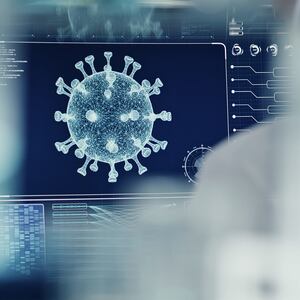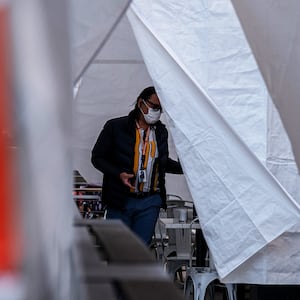A potentially dangerous new form of the coronavirus, or “lineage,” as geneticists call it, is spreading across New York City, scientists reported this week. They worry the new lineage, B.1.526, could be more transmissible and partially resistant to existing COVID-19 vaccines.
In the worst-case scenario, B.1.526 could arrest recent progress reducing new infections and hospitalizations and delay, by weeks or months, the eventual suppression of the pathogen in the state where it exploded last spring. But if there’s a silver lining in B.1.526’s dark cloud, it’s that it shares its worst qualities with several other coronavirus lineages. And many of the countries where those new lineages are now dominant have figured out how to beat them.
Welcome to Rabbit Hole, where we dive deep on the biggest story. It’s for Beast Inside members only. Join up today.
ADVERTISEMENT
If a lineage is more transmissible, beating it means wearing at least one mask while indoors or in public, ventilating buildings, and avoiding crowds—and then getting vaccinated as soon as you’re eligible.
In other words, the same methods that also work against older forms of the coronavirus.
“This seems to follow a similar general pattern,” Stephen Jameson, a University of Minnesota immunologist, told The Daily Beast.
The question is whether a pandemic-weary population—and, under the Biden administration, increasingly impatient state governments—can keep up their guard. There are already signs of caving, as governors move to reopen in both Democratic and Republican-controlled locales.
A collapse in social distancing could be just the thing the mutation-juiced pathogen needs to build to yet another spike in infections and deaths late this year. “We could end up in a heap of trouble in the winter,” warned Irwin Redlener, the founding director of Columbia University’s National Center for Disaster Preparedness.
B.1.526 first appeared in samples authorities collected in November. Today, the lineage accounts for around a fifth of all infections in New York City, according to Christopher Mason, a biophysicist whose team at Weill Cornell Medicine is tracking coronavirus lineages across the city.
Scientists raced to decode B.1.526. One study, led by a group at Caltech, was published on Tuesday. Another, from Columbia University, appeared on Thursday. Both studies have yet to be peer-reviewed, but they seem to tell a similar story.
According to this initial research, B.1.526 includes two key mutations. The E484K mutation, which is also present in new lineages from South Africa and Brazil, could reduce the effectiveness of vaccines. Another mutation, S477N, affects the spike protein that helps SARS-CoV-2 grab onto, and infect, our cells.
In other words, it could make the pathogen more transmissible. New York, like most states and many countries, has seen a significant drop in new coronavirus infections and hospitalizations in recent weeks. New cases peaked at around 16,500 a day in early January. Now they’re down to just 7,500 a day.
The drop in cases is buying time for health authorities to ramp up vaccinations: About 2.6 million New York residents—that’s 13 percent of the state’s population—have gotten at least one dose of vaccine.
B.1.526 threatens to upset that progress. “If we don’t have sustained and even more active adherence to the public health recommendations, then all bets may be off,” Redlener told The Daily Beast.
Those recommendations haven’t changed, they’ve just become more urgent. “The best way for New Yorkers to protect themselves is what we’ve said from the beginning,” Jonah Bruno, a spokesperson for the New York Department of Health, told The Daily Beast. “Continue to wear a well-fitted mask, avoid large crowds, social distance, wash your hands, and get vaccinated when it’s your turn.”
There’s reason to be optimistic that, with a few months of extra vigilance, New York—and any other state or community on the receiving end of a dangerous new lineage, like the one in California—can cement its progress against the novel coronavirus.
Just look at the United Kingdom, which last fall had one of the highest rates of new infections in the world, owing in part to the spread of the homegrown B.1.1.7 lineage, or “U.K. Variant.”
B.1.1.7 has a lot in common with B.1.526 and other major new forms of the coronavirus—namely, mutations that could increase transmissibility while potentially decreasing the effectiveness of vaccines.
The government reaction was swift. “We’ve been in a pretty strict lockdown across the U.K. basically since before Christmas,” Devi Sridhar, a professor of public health at the University of Edinburgh, told The Daily Beast. “Schools shut, non-essential shops shut, no indoor mixing at all, pubs and hospitality shut, pretty strong travel ban.”
“Even with that, B 1.1.7 is proving hard to suppress,” Sridhar added.
But suppress it, the United Kingdom has. New infections peaked at 60,000 a day in early January. Today they’re down to around 10,500 a day as people stay home and the number of people who’ve received at least one dose of vaccine approaches 18.5 million, or 30 percent of the country.
The United Kingdom isn’t out of the woods. Wary of the economic damage resulting from a prolonged shutdown, the government has announced a relaxing of public health measures starting on March 8. That’s when B.1.1.7 or some other lineage might come roaring back.
“This is a very risky time, and we need to remain vigilant to ensure that the number of cases and hospitalizations does not go out of control,” Duncan Robertson, a policy analyst at the U.K.’s Loughborough University, told The Daily Beast.
The risk is the same in New York. B.1.526 surely isn’t done spreading. Vaccination is ramping up, but at the current rate it will be many months before all New Yorkers will have access to a shot.
And yet, the state is beginning to relax its social distancing rules. Movie theaters can reopen starting March 5. The government is allowing large weddings beginning March 15. New York is reopening just as its unique viral lineage is becoming dominant.
If the government won’t compel people to practice sound public health, it’s up to everyday people to do it on their own.
“Mass distancing, hygiene and ventilation,” Redlener stressed. “If we’re not doing that and we’re waiting for vaccines to solve the crisis, we’re going to have a much more prolonged and dangerous experience.”







